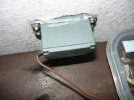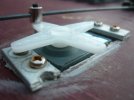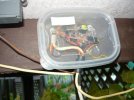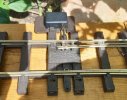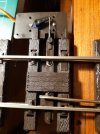GAP
G Scale Model Trains, 1:1 Sugar Cane Trains
OK folks just some clarification;
The mid winter overnight temperature here rarely goes below 10C at the coldest time of the year.
The installation has been installed for over 2 weeks and subjected to over 80mm of rain over the 4 days of Easter plus heavy dew every night since.
The baseboard is fibre cement shower lining so it is fairly impervious to water ingress even before it was painted with cement paving paint (red side up grey side down). You may not realise that the baseboard is 800 mm above ground so airflow above and below is extremely good.
The temperature today was 31C and when I was under the baseboard tidying up some wiring I was dripping sweat after 25 minutes.
The servos were sold as "waterproof" for model boat use and do not have the visible joins that are on my other servos.
So after some user trials, where the moisture inside the tester enclosures and at the servos was monitored closely, I am confident that moisture ingress will not be a major issue.
Yes the servos are mounted with the majority of their body below the baseboard with the top protruding through a hole cut in the baseboard; so technically they are not mounted under the baseboard but it is close enough.
The hole through the baseboard is larger than the servo body so water ponding is not an issue.
I think I remember posting that I am smearing some silicone grease around the shaft to improve water repellence.
Also all the circuit boards and any moisture ingress points are coated with printed circuit board coating.
I am not planning on covering the servo; mainly because a cover will be a place where condensation could form and be trapped under, probably better leaving it open to the air and let evaporation do its thing.
Hope this explains the situation.
And PhilP the layout is always powered off at the end of a running session
The mid winter overnight temperature here rarely goes below 10C at the coldest time of the year.
The installation has been installed for over 2 weeks and subjected to over 80mm of rain over the 4 days of Easter plus heavy dew every night since.
The baseboard is fibre cement shower lining so it is fairly impervious to water ingress even before it was painted with cement paving paint (red side up grey side down). You may not realise that the baseboard is 800 mm above ground so airflow above and below is extremely good.
The temperature today was 31C and when I was under the baseboard tidying up some wiring I was dripping sweat after 25 minutes.
The servos were sold as "waterproof" for model boat use and do not have the visible joins that are on my other servos.
So after some user trials, where the moisture inside the tester enclosures and at the servos was monitored closely, I am confident that moisture ingress will not be a major issue.
Yes the servos are mounted with the majority of their body below the baseboard with the top protruding through a hole cut in the baseboard; so technically they are not mounted under the baseboard but it is close enough.
The hole through the baseboard is larger than the servo body so water ponding is not an issue.
I think I remember posting that I am smearing some silicone grease around the shaft to improve water repellence.
Also all the circuit boards and any moisture ingress points are coated with printed circuit board coating.
I am not planning on covering the servo; mainly because a cover will be a place where condensation could form and be trapped under, probably better leaving it open to the air and let evaporation do its thing.
Hope this explains the situation.
And PhilP the layout is always powered off at the end of a running session

